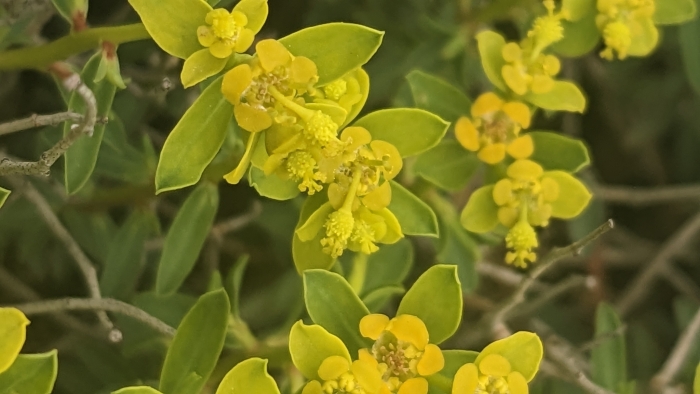Spiny Spurge
(Euphorbia spinosa)
Spiny Spurge (Euphorbia spinosa)
/
/

engagenosey
CC BY 4.0
Image By:
engagenosey
Recorded By:
Copyright:
CC BY 4.0
Copyright Notice:
Photo by: engagenosey | License Type: CC BY 4.0 | License URL: http://creativecommons.org/licenses/by/4.0/ | Rights Holder: engagenosey | Publisher: iNaturalist | Date Created: 2023-04-02T13:50:12-07:00 |






















Estimated Native Range
Summary
Euphorbia spinosa, commonly known as Spiny Spurge or Mediterranean Spurge, is a perennial shrub native to the Mediterranean region, particularly thriving in garrigue and maquis habitats, as well as in dry hillsides and coastal areas. It is adapted to the rocky, calcareous soils found in these environments and is a key component of the Mediterranean scrub ecosystem. The plant typically grows at a moderate rate to a height of 1-3 feet (0.3-0.9 meters) and a width of 1-2 feet (0.3-0.6 meters). Spiny Spurge has a distinctive appearance with its spiny, woody stems and small, yellow or green flowers that bloom in the spring and summer. The flowers are not particularly showy but are interesting upon close inspection.
This shrub is valued for its drought tolerance and its ability to thrive in poor soils, making it a suitable choice for xeriscaping and rock gardens. It is also used in coastal landscaping due to its salt tolerance. Spiny Spurge requires minimal maintenance once established and can be an effective ground cover in hot, dry areas. It is best grown in full sun or part shade and prefers medium or fast-draining sandy or loamy soils with low water requirements. While generally pest-free, it can be susceptible to root rot if overwatered. Gardeners should handle this plant with care, as the sap can be irritating to the skin and eyes.CC BY-SA 4.0
This shrub is valued for its drought tolerance and its ability to thrive in poor soils, making it a suitable choice for xeriscaping and rock gardens. It is also used in coastal landscaping due to its salt tolerance. Spiny Spurge requires minimal maintenance once established and can be an effective ground cover in hot, dry areas. It is best grown in full sun or part shade and prefers medium or fast-draining sandy or loamy soils with low water requirements. While generally pest-free, it can be susceptible to root rot if overwatered. Gardeners should handle this plant with care, as the sap can be irritating to the skin and eyes.CC BY-SA 4.0
Plant Description
- Plant Type: Shrub
- Height: 1-3 feet
- Width: 1-2 feet
- Growth Rate: Moderate
- Flower Color: Yellow, Green
- Flowering Season: Spring, Summer
- Leaf Retention: Deciduous
Growth Requirements
- Sun: Full Sun, Part Shade
- Water: Low
- Drainage: Medium, Fast
Common Uses
Border Plant, Drought Tolerant, Low Maintenance, Rock Garden
Natural Habitat
Native to garrigue and maquis habitats, dry hillsides, and coastal areas within the Mediterranean region
Other Names
Common Names: Mediterranean Spurge
Scientific Names: , Euphorbia spinosa, Euphorbia linearifolia, Euphorbia petalioides, Euphorbia petalodes, Euphorbia rigida, Euphorbia rigida, Euphorbia spinescens, Galarhoeus spinosus, Tithymalus spinosus
GBIF Accepted Name: